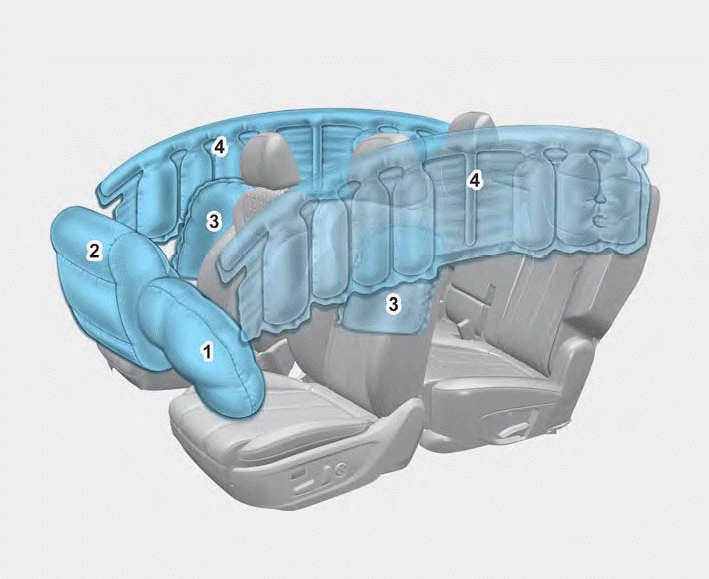Hyundai Santa Fe: Why didn’t my air bag go off in a collision? / Air bag inflation conditions
Front air bags
.png)
Front air bags are designed to inflate in a frontal collision depending on the severity of impact of the front collision.
.png)
.png)
Side and curtain air bags
Side and curtain air bags are designed to inflate when an impact is detected by side collision sensors depending on the severity, speed or angles of impact resulting from a side impact collision.
Although the driver’s and front passenger’s air bags are designed to inflate in frontal collisions, they also may inflate in other types of collisions if the front impact sensors detect a sufficient impact. Side and curtain air bags are designed to inflate in side impact collisions, but they may inflate in other collisions if the side impact sensors detect a sufficient impact.
Also, the side and curtain air bags are designed to inflate when a rollover is detected by a rollover sensor. (if equipped with rollover sensor)
If the vehicle chassis is impacted by bumps or objects on unimproved roads, the air bags may deploy. Drive carefully on unimproved roads or on surfaces not designed for vehicle traffic to prevent unintended air bag deployment.
 Air bag collision sensors
Air bag collision sensors
WARNING
To reduce the risk of an air bag deploying unexpectedly and causing serious
injury or death:
Do not hit or allow any objects to impact the locations where air
bags or sensors are installed...
 Air bag non-inflation conditions
Air bag non-inflation conditions
In certain low-speed collisions the air bags may not deploy. The air bags are
designed not to deploy in such cases because they may not provide benefits beyond
the protection of the seat belts...
Other information:
Hyundai Santa Fe (TM) 2019-2025 Owner's Manual: TPMS malfunction indicator
The TPMS Malfunction Indicator will illuminate after it blinks for approximately one minute when there is a problem with the Tire Pressure Monitoring System. We recommend that you have the system checked by an authorized HYUNDAI dealer as soon as possible...
Hyundai Santa Fe (TM) 2019-2025 Service Manual: Description and operation
Description The charging system includes a battery, an alternator with a built-in regulator, and the charging indicator light and wire. The Alternator has eight built-in diodes, each rectifying AC current to DC current. Therefore, DC current appears at alternator "B" terminal...
Categories
- Manuals Home
- 4th Generation Santa Fe Owners Manual
- 4th Generation Santa Fe Service Manual
- Electronic Parking Brake (EPB) warning light. AUTO HOLD indicator light
- Body (Interior and Exterior)
- Instrument panel overview
- New on site
- Most important about car
Air bag - supplemental restraint system

1. Driver’s front air bag
2. Passenger’s front air bag
3. Side air bag
4. Curtain air bag
The vehicles are equipped with a Supplemental Air Bag System for the driver’s seat and front passenger’s seats.
The front air bags are designed to supplement the three-point seat belts. For these air bags to provide protection, the seat belts must be worn at all times when driving.
